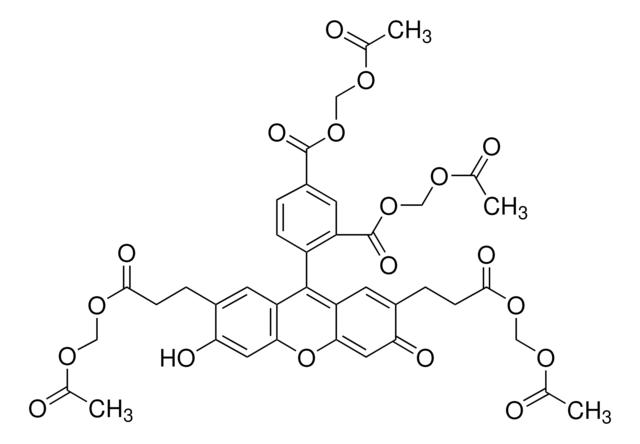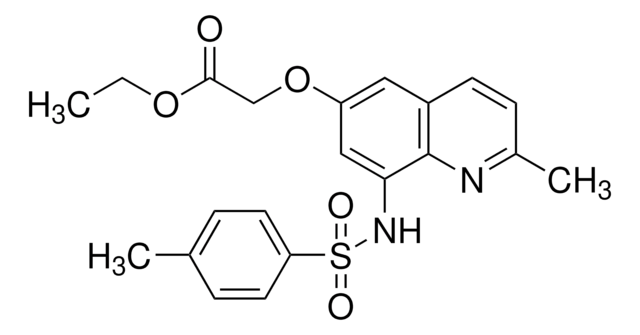Wichtige Dokumente
46123
1-(Ethoxycarbonylmethyl)-6-methoxychinoliniumbromid
suitable for fluorescence, ≥97.0% (TLC)
Synonym(e):
(6-Methoxychinolinio)-essigsäure-ethylester-bromid, MQAE
About This Item
Empfohlene Produkte
Qualitätsniveau
Assay
≥97.0% (TLC)
Form
solid
mp (Schmelzpunkt)
177-179 °C (lit.)
Löslichkeit
DMSO: soluble
H2O: soluble
methanol: soluble
Fluoreszenz
λex 350 nm; λem 460 nm in 0.1 M borate pH 8.0 (quenching with Cl-)
Eignung
suitable for fluorescence
Lagertemp.
2-8°C
SMILES String
[Br-].CCOC(=O)C[n+]1cccc2cc(OC)ccc12
InChI
1S/C14H16NO3.BrH/c1-3-18-14(16)10-15-8-4-5-11-9-12(17-2)6-7-13(11)15;/h4-9H,3,10H2,1-2H3;1H/q+1;/p-1
InChIKey
DSLLHVISNOIYHR-UHFFFAOYSA-M
Suchen Sie nach ähnlichen Produkten? Aufrufen Leitfaden zum Produktvergleich
Anwendung
Sonstige Hinweise
Signalwort
Warning
H-Sätze
Gefahreneinstufungen
Eye Irrit. 2 - Skin Irrit. 2 - STOT SE 3
Zielorgane
Respiratory system
Lagerklassenschlüssel
11 - Combustible Solids
WGK
WGK 3
Flammpunkt (°F)
Not applicable
Flammpunkt (°C)
Not applicable
Persönliche Schutzausrüstung
dust mask type N95 (US), Eyeshields, Gloves
Hier finden Sie alle aktuellen Versionen:
Besitzen Sie dieses Produkt bereits?
In der Dokumentenbibliothek finden Sie die Dokumentation zu den Produkten, die Sie kürzlich erworben haben.
Artikel
Nitric oxide (NO) as a signal transporter in neurons, endothelial cells and in the immune system.
Unser Team von Wissenschaftlern verfügt über Erfahrung in allen Forschungsbereichen einschließlich Life Science, Materialwissenschaften, chemischer Synthese, Chromatographie, Analytik und vielen mehr..
Setzen Sie sich mit dem technischen Dienst in Verbindung.







